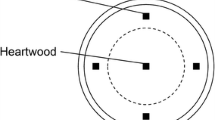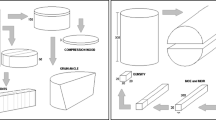Abstract
The heartwood ofPinus sylvestris (Scots pine or Baltic redwood) is known to contain natural chemicals (extractives) that confer a measure of resistance to decay by cellulolytic and lignolytic wood-destroying fungi. It is also known that the heartwood nearest the pith (juvenile heartwood) is frequently less resistant than the mature heartwood and can become rapidly decayed under appropriately damp conditions.
Window joinery in the UK is manufactured substantially fromP. sylvestris and the extent of natural resistance to decay of the heartwood, and of any changes that may occur with time in service, is therefore of great practical and economic relevance.
Investigations have been carried out at PRL in which small blocks (20 × 5 × 5 mm) have been excised from the relevant zones of new, joinery-grade timber and from timber previously in service as window joinery for periods of up to 10 yr. After sterilization, the blocks were exposed to attack byConiophora puteana (FPRL No HE) for a period of 4 wk and the weight loss of the blocks was assessed.
Results with new timber confirmed that the mature heartwood is significantly more durable than the juvenile heartwood, which in turn is significantly more durable than the sapwood (0.1% probability level in each case).
With timber from service, different results were obtained. From regions protected by paint and remote from the effects of water penetration via the joint, the mature heartwood was still more durable than juvenile heartwood, but the difference was less significant (5% probability level). However in the region of the joints, which are subject to wetting and the microbial colonization that accompanies it, the mature heartwood had become significantly less durable than the mature heartwood from the protected region. Furthermore, it was no longer more durable than the juvenile wood associated with it.
The precise mechanism of the change in durability of the mature wood is still not known. Leaching of water-soluble extractives is thought unlikely since the main extractives present inP. sylvestris (pinosylvins) are not markedly water-soluble and in any case, although water enters the timber components in the liquid phase, subsequent loss occurs in the vapor phase and not by mass flow. It seems more likely that the effect is a result of the activity of the mixed microflora of bacteria, yeasts, molds, and blue-stain fungi that have already been shown to be the early colonizers of pine joinery in service. Possibly the microbial activity serves to detoxify the inhibitory extractives or to render the heartwood more susceptible to cellulolytic and lignolytic systems by some nutritional or microstructural means.
Similar content being viewed by others
Author information
Authors and Affiliations
Rights and permissions
About this article
Cite this article
Carey, J.K., Savory, J.G., Mendes, F. et al. Loss of resistance to decay of scots pine heartwood in a biologically active environment. Appl Biochem Biotechnol 9, 343–344 (1984). https://doi.org/10.1007/BF02798967
Issue Date:
DOI: https://doi.org/10.1007/BF02798967




